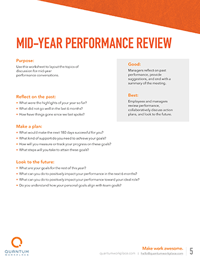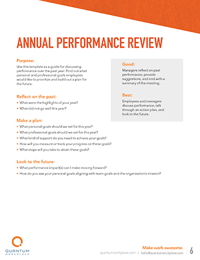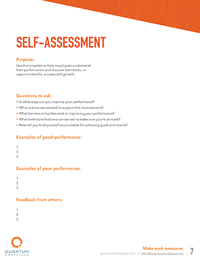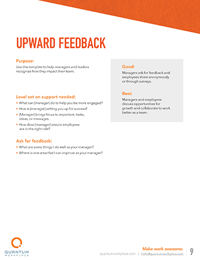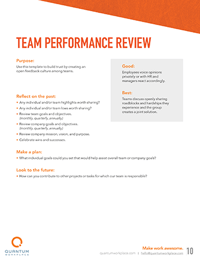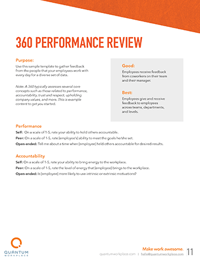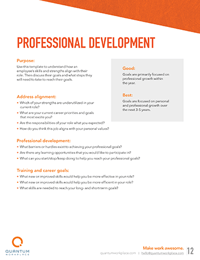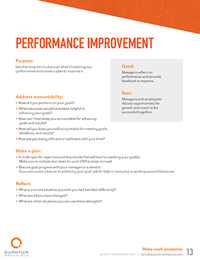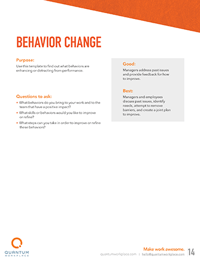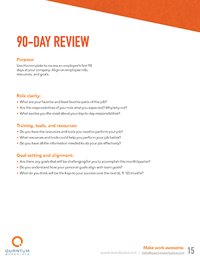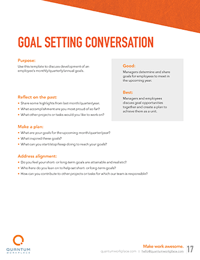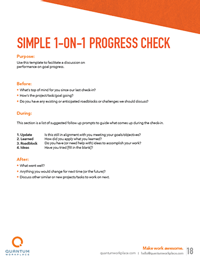16 Performance Review Templates to Help HR Streamline Success
A strong performance review template is more than a form — it’s a tool that builds clarity, trust, and real growth. When your performance review form is structured well, managers and employees stay aligned on expectations, focus on meaningful behaviors and results, and have fair, productive conversations. With consistency and space for honest feedback, a good employee review template creates transparency and drives better development and engagement across your organization.
Key Takeaways
- A good performance review template (or employee review form) ensures consistency across teams — the same evaluation criteria reduces bias.
- Templates make feedback more actionable and useful: they encourage managers to give specific examples, balanced praise and improvement notes, and clearly defined development goals.
- A structured template saves time and removes uncertainty, letting managers focus on meaningful conversation instead of reinventing the review process each cycle.
- By linking evaluations to measurable competencies, performance goals, and growth plans, an employee review template helps align individual effort with broader organizational objectives.
- Effective review forms give employees a voice too — through self-assessment sections and open comment fields — which supports engagement, ownership, and trust in the review process.
The Importance of Constructive Feedback in Performance Reviews
Perhaps the most essential component of performance reviews is constructive feedback. Performance feedback plays a vital role in boosting employee performance and expediting growth. It helps managers help employees grow, develop, and improve. Great feedback is:
- Specific: uses examples and data
- Frequent: is timely, not saved for annual review conversations
- Outcome-focused: put into context of meaningful performance goals and objectives
- Positive: shares what employees are doing well
- Conversational: encourages employees to share their perspective
Quantum Workplace research shows that employees who receive more frequent feedback are 2X more engaged, 3X less likely to apply or seek other jobs, and 1.4X more likely to stay at your organization. Helpful feedback isn't just a soft suggestion—it's key to engagement and retention!
Check out our 170+ performance review examples, comments, and phrases to inspire your next employee review.
What Is a Performance Review Template?
A performance review template is a structured form used to guide employee evaluation conversations. It helps managers stay consistent, outline expectations, assess performance fairly, and document progress using clear criteria. A strong template also ensures employees understand how they’re being evaluated, what they’re doing well, and where they can grow.
Using a performance review template, employee review template, or employee review form keeps the process focused, organized, and easier for both managers and employees.
For HR teams, this consistency is key. Templates reduce bias, standardize performance conversations across the organization, strengthen compliance documentation, and generate clean, comparable performance data—making it easier to identify trends, support managers, and improve the overall performance management process.
Why Use a Performance Review Template?
Using a performance review template makes it easier for managers to understand the role of performance reviews and deliver feedback that actually helps employees grow. A structured employee review template or employee review form ensures conversations stay focused, fair, and consistent.
Templates also help managers provide constructive feedback, highlighting strengths and areas for improvement in a way that motivates employees. For HR, this consistency is crucial—it ensures every employee receives clear, actionable guidance, supports fair evaluation, and makes performance data easier to track and analyze across the organization.
What are the key elements of a good performance review template?
A best practices performance review form includes clear and specific performance criteria. It includes examples of employee accomplishments and areas for improvement, taking a balanced approach. It should include a rating system—but don't make the rating the central focus. It should have plenty of space for comments and feedback for the reviewer and the employee. And it should be focused on the future, helping fuel employee growth with goals and development plans.
Key Components of an Effective Performance Review Template
An effective performance review process involves several key components. Each component helps ensure review conversations are meaningful, transparent, and fair. A well-designed performance appraisal template provides consistent structure across the organization. It also reduces the administrative burden on managers. Managers can launch effective conversations with ease.
- Rating scale. A rating scale helps quantify employee performance using predefined criteria. It allows for a fair and standardized evaluation process. Be careful not to focus too much on the rating in the actual review conversation. It's meant to help identify gaps in perception between managers and employees—not serve as a focal point.
- Performance review summary. A summary provides an overview of an employee's overall performance during the review period. It should cover a holistic view of contributions, accomplishments, and areas for improvement.
- Performance goals. Performance goals should be central to any performance conversation. Managers and employees should take part in goal-setting together outside of the review. Review conversations should address progress, performance, and next steps on those goal identified as key performance goals.
- Performance competencies. Review should include core competencies necessary for job performance and development. Assessing relevant skills such as communication, teamwork, and problem-solving can help identify role-related strengths and areas in need of development.
- Templated questions. Outside of goals and competencies, what else is important to employee success in your organization? Create a fuller picture of performance by incorporating performance review questions on company core values, organizational priorities, required trainings, or other areas of interest.
- Two-way comments. This might be the most important component of any performance review process. Expect managers and employees to participate equally. Employees should clearly understand the topics of discussion. And they should have the chance to contribute through self-rating and contextual comments.
What to avoid in an employee performance review template?
There are a few things to avoid in your performance reviews. Your performance review templates can help address some of these performance review pitfalls:
- Don't include vague or unclear language. Instead, be specific and to the point. Encourage managers and employees to include specific examples and behaviors in their comments.
- Don't let bias or subjectivity creep in. Having good data on employee performance throughout the year helps. Think feedback, recognition, goal progress, and more.
- Don't take a "kitchen sink" approach. If there are too many factors to evaluate, reviews will easily get out of hand and lack focus. Focus on the most important goals and competencies.
Types of performance review templates
Employee review templates bring consistency, clarity, and structure to your performance conversations. They support managers and employees with guided questions, aligned goals, and thoughtful reflection. Use the following employee review templates throughout your performance cycle to create a rhythm of meaningful, growth-focused conversations.
16 Types of Performance Review Templates:
-
Good Performance Review Template
-
Quarterly Check-In Template
-
Mid-Year Performance Review Template
-
Annual Performance Review Template
-
One-Page Performance Review Template
-
Self-Assessment Template
-
Upward Feedback Template
-
Team Performance Review Template
-
360 Performance Review Template
-
Professional Development Template
-
Performance Improvement Template
-
Behavior Change Template
-
Compensation Check-In Template
-
90-Day Review Template
-
Goal Setting Conversation Template
-
Simple 1-on-1 Progress Check Template
1. GOOD Performance Review Template
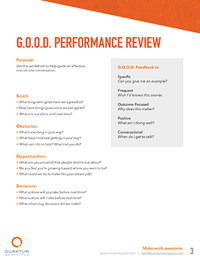
The GOOD template is a special template to us! Quantum Workplace uses this template for our own monthly manager-employee performance conversations. It's a staple of our company culture (learn more about that here!).
A GOOD stands for Goals, Obstacles, Opportunities, and Decisions. This template is great for monthly 1-on-1s. It helps managers and employees zoom out and revisit the big picture.
Goals:
- What long-term goals have we agreed to?
- How have things gone since we last spoke?
- What are our plans until next time?
Obstacles:
- What's standing in your way?
- What have I noticed getting in your way?
- What can I do to help you?
Opportunities:
- What are you proud of that people don't know about?
- Do you feel you're growing toward where you need to be?
- What could be done to make this your dream job?
Decisions:
- What actions will you take before next time?
- What actions will I take before next time?
- What other big decisions did we make?
Pros: Encourages conversation, reflection, and future planning
Cons: Doesn't include metrics by which to measure or compare employees (we don't encourage that anyway)
2. Quarterly Check-In Template
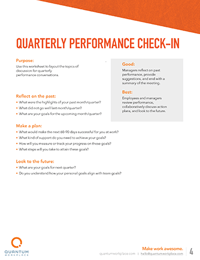
If monthly performance conversations aren't feasible, we recommend they be at least quarterly. Managers and direct reports should collaboratively review an employee's performance, discuss action plans, and look to the future. This worksheet will guide you through topics of discussion for quarterly performance conversations.
Reflect on the past:
- What were the highlights of your past month/quarter?
- What did not go well last month/quarter?
- What are your goals for the upcoming month/quarter?
Make a plan:
- What would make the next 60-90 days successful for you at work?
- What kind of support do you need to achieve your goals?
- How will you measure or track your progress on these goals?
- What steps will you take to attain these goals?
Look to the future:
- What are your goals for next quarter?
- Do you understand how your personal goals align with team goals?
Pros: Employees and managers can act on findings more quickly
Cons: Isn't always focused on the long-term goals of the company and the employee
3. Mid-Year Performance Review Template
A mid-year performance review is a prime opportunity to check on goals and adjust them as needed. It should focus on key highlights, obstacles, and a plan for the future.
Reflect on the past:
- What were the highlights of your year so far?
- What did not go well in the last 6 months?
- How have things gone since we last spoke?
Make a plan:
- What would make the next 180 days successful for you?
- What kind of support do you need to achieve your goals?
- How will you measure or track your progress on these goals?
- What steps will you take to achieve these goals?
Look to the future:
- What are your goals for the rest of this year?
- What can you do to positively impact your performance in the next 6 months?
- What can you do to positively impact your performance toward your ideal role?
- Do you understand how your personal goals align with team goals?
Pros: Allows managers and employees to recalibrate before the year is over
Cons: Leaves a long gap between performance reviews if this is all you do
4. Annual Performance Review Template
The annual performance review is for summarizing performance across the year. It's also a good opportunity to discover what goals employees would like to prioritize before the next performance review.
Reflect on the past:
- What were the highlights of your year?
- What did not go well this year?
Make a plan:
- What personal goals should we set for this year?
- What professional goals should we set for this year?
- What kind of support do you need to achieve your goals?
- How will you measure or track your progress on these goals?
- What steps will you take to attain these goals?
Look to the future:
- What performance impact(s) can I make moving forward?
- How do you see your personal goals aligning with team goals and the organization’s mission?
Pros: Allows managers and employees to look at the big picture of an employee's performance
Cons: It's tough to review an entire year of performance in one conversation
5. One-Page Performance Review Template
If you're looking for the absolute basics, check out this one-page employee evaluation form from Seismic.
Pros: Quick and straightforward—has a defined rating scale
Cons: Leaves little room for additional information; doesn't encourage two-way discussion
6. Self-Assessment Template
A self-assessment review helps employees reflect on their own performance. They can identify barriers and opportunities to discuss with their managers. It helps employees have a voice in their own career pathing—and provides managers with valuable coaching insight.
Questions to ask:
- In what ways can you improve your performance?
- What actions are needed to support the improvement?
- What barriers or hurdles exist to improve your performance?
- What metrics/milestones can we use to ensure you’re on track?
- How will you hold yourself accountable for achieving goals and results?
Share examples of good performance:
1.
2.
3.
Share examples where you could improve:
1.
2.
3.
Pros: Instills reflective habits in employees and encourages them to own their own performance
Cons: Doesn't account for feedback from peers and managers
7. Upward Feedback Template
It's important for managers to gather feedback on their own performance as well. Upward feedback allows employees to share feedback on their manager with their manager's boss. After receiving this feedback, managers can discuss areas of opportunity and collaborate with their team to grow and improve.
Level set on support needed:
- What can [manager] do to help you be more engaged?
- How is [manager] setting you up for success?
- [Manager] brings focus to important, tasks, ideas, or messages.
- How does [manager] ensure employees are in the right role?
Ask for feedback:
- What are some things I do well as your manager?
- What is one area that I can improve as your manager?
Pros: Opens up the door for a two-way conversation about manager effectiveness
Cons: Employees might be worried about the consequences of providing feedback
8. Team Performance Review Template
High-performing teams are the key to organizational success. Use this template to build trust by creating an open feedback culture among teams. Ideally, teams can discuss performance openly, sharing roadblocks and hardships and developing solutions.
Reflect on the past:
- Any individual and/or team highlights worth sharing?
- Any individual and/or team lows worth sharing?
Review team goals and objectives (monthly, quarterly, annually):
- Review company mission, vision, and purpose.
- Celebrate wins and successes.
Make a plan:
- What individual goals could you set that would help assist overall team or company goals?
Look to the future:
- How can you contribute to other projects or tasks for which our team is responsible?
Pros: Gives a sense of how an overall team, not just individuals, is performing
Cons: Extremely high or low scores by a few individuals can skew results
9. 360 Performance Review Template
A 360 review helps managers get feedback from an employee's team. Managers can develop a broader perspective of an employee's performance, shedding light on strengths or challenges that might not be obvious. Use this sample template to gather feedback from the people that your employees work with every day for a diverse set of data.
Note: A 360 typically looks at several core concepts such as those related to performance, accountability, trust and respect, upholding company values, and more. This is example content to get you started.
Performance Self: On a scale of 1-5, rate your ability to hold others accountable.
- Peer: On a scale of 1-5, rate [employee’s] ability to meet the goals he/she set.
- Open-ended: Tell me about a time when [employee] held others accountable for desired results.
Accountability Self: On a scale of 1-5, rate your ability to bring energy to the workplace.
- Peer: On a scale of 1-5, rate the level of energy that [employee] brings to the workplace.
- Open-ended: Is [employee] more likely to use intrinsic or extrinsic motivations?
Pros: Shines a light on the entirely of an employee's actions, not just what the manager witnesses
Cons: Could be difficult for some employees to judge accurately
10. Professional Development Template
Professional development and career growth are key drivers of employee engagement and performance. Use this template to check on the alignment of employee strengths, skills, goals, and job role. Then discuss their goals and what steps they will need to take to reach their goals. Focus on career development and growth over the next 3-5 years.
Address alignment:
- Which of your strengths are underutilized in your current role?
- What are your current career priorities and goals that most excite you?
- How do you think this job aligns with your personal values?
Discuss development:
- What barriers or hurdles exist to achieving your professional goals?
- Are there any learning opportunities that you would like to participate in?
- What can you start/stop/keep doing to help you reach your professional goals?
Talk through training and goals:
- What new or improved skills would help you be more effective in your role?
- What new or improved skills would help you be more efficient in your role?
- What skills are needed to reach your long- and short-term goals?
Pros: Allows aligned expectations to be compared pre- and post-performance cycle
Cons: Can be fairly general
11. Performance Improvement Template
If an employee isn't meeting expectations, it might be time for performance improvement plan. Use this template to discover what's hindering performance and to create a plan to improve it. Managers and employees can discuss opportunities and work toward success together.
Address accountability:
- How did you perform on your goals?
- What resources would have been helpful in achieving your goals?
- How can I help keep you accountable for achieving goals and results?
- How will you keep yourself accountable for meeting goals, deadlines, and results?
- How are you being efficient or inefficient with your time?
Make a plan:
- Include specific objectives and key results that will lead to reaching your goal(s). Make sure to include due dates for each OKR or SMART goal to keep on track.
- Discuss goal progress with your manager or a mentor.
- If you encounter a barrier to achieving your goal, ask for help in removing or working around the barrier.
Reflect:
- What is a recent situation you wish you had handled differently?
- What would you have changed?
- What are other situations you can use these strengths?
Pros: Can course-correct declining performance and give employees a fair chance to improve
Cons: Can be disengaging
12. Behavior Change Template
Employee behaviors can have a big impact on individual and team success. Use this template to understand and address behaviors that are helping or hindering performance.
Questions to ask:
- What behaviors do you bring to your work and to the team that have a positive impact?
- What skills or behaviors would you like to improve or refine?
- What steps can you take in order to improve or refine these behaviors?
Pros: Helps managers and employees identify issues, needs and barriers together
Cons: An effective conversation can only be had with a self-driven employee
13. Compensation Check-In
It's important for managers and employees to talk openly about an employee's compensation. Use this template to talk about compensation, benefits, bonuses, and pay with employees. Managers and employees can get on the same page, answer questions, and keep an open door.
Check in:
- What questions do you have about how you are paid?
- What questions do you have about our benefits package?
Follow up:
- What compensation goals do you have for yourself in the next five or ten years?
- What questions do you have about the benefits you are currently receiving?
- How could the organization help you better utilize our benefits?
- What other benefits would you add to our benefits package?
Pros: Encourages pay transparency among organizations, managers, and employees
Cons: Employee expectations can't be met all the time
14. 90-Day Review Template
New hires deserve to know how they're doing. Use this template to review an employee's first 90 days at an organization after employee onboarding. It will help you set short-term goals and a shared vision for the future and align on role, resources, and goals.
Role clarity:
- What are your favorite and least favorite parts of this job?
- Are the responsibilities of your role what you expected? Why/why not?
- What excites you the most about your day-to-day responsibilities?
Training, tools, and resources:
- Do you have the resources and tools you need to perform your job?
- What resources and tools could help you perform your job better?
- Do you have all the information needed to do your job effectively?
Goal setting and alignment:
- Are there any goals that will be challenging for you to accomplish this month/quarter?
- Do you understand how your personal goals align with team goals?
- What do you think will be the keys to your success over the next (6, 9, 12) months?
Pros: Helps provide clarity and early performance feedback for new hires
Cons: Limited to manual labor employees
15. Goal Setting Conversation Template
Goal-setting conversations are an important piece of your performance management puzzle. Your employees need measurable, aligned goals to work toward. Use this template to develop an employee's monthly, quarterly, or annual goals.
Reflect on the past:
- Share some highlights from last month/quarter/year.
- What accomplishment are you most proud of so far?
- What other projects or tasks would you like to work on?
Make a plan:
- What are your goals for the upcoming month/quarter/year?
- What inspired these goals?
- What can you start/stop/keep doing to reach your goals?
Address alignment:
- Do you feel your short- or long-term goals are attainable and realistic?
- Who here do you lean on to help set short- or long-term goals?
- How can you contribute to other projects or tasks for which our team is responsible?
Pros: Helps managers and employees set aligned, measurable goals
Cons: Will not be effective if not discussed regularly throughout the performance cycle
16. Simple 1-on-1 Progress Check
Formal performance conversations are important. But it's also important that managers and employees keep in touch with weekly check-ins. These quick conversations allow managers and employees to address obstacles in real-time. Use this template to facilitate a weekly check in on performance and progress.
- What’s top of mind for you since our last check-in?
- How’s the project/task/goal going?
- Do you have any existing or anticipated roadblocks or challenges we should discuss?
Pros: Quick and frequent check-ins allow for better communication and agility
Cons: Managers need to set dedicated time aside for each employee
Elevating performance reviews from administrative tasks to strategic initiatives
Performance reviews help align teams with your organization’s goals, drive employee and business success, and boost engagement and culture. By highlighting the value of feedback, reviews can become tools for development and career growth.
Simple performance review templates help HR and managers:
- Streamline the process. Templates take some effort to set up, but once in place, reviews are easy to launch and complete, saving time and keeping focus on meaningful work.
- Create consistency. Templates ensure managers evaluate performance fairly and consistently, helping employees see the process as clear and objective.
- Give better feedback. Feedback is a skill that improves with practice. Templates provide structure to make feedback clear, actionable, and growth-focused.
How Quantum Workplace can help you streamline performance reviews
Performance conversations don’t need to be hard. Keep your managers and employees on the same page with engaging performance reviews. Our performance review software gives your teams reliable context to help them have more objective and engaging conversations.
|
|
1. Customize reviews to fit your needs.Easily measure what you want, when you want with flexible review modules that you can tailor to fit the needs of your culture and the various groups within it. |
2. Help your managers build positive performance habits.Make it easy for manager to coach to performance by integrating your process into their existing workflows. Set up formal conversation cycles to create the right frequency and consistency of touch points. |

|

|
3. Easily track review response rates.See the status of each review cycle to help your teams stay accountable and monitor performance ratings in real-time. |
4. Embed performance goals directly into reviews.Our platform makes it easy to include goals as part of performance evaluations—and helps coach managers have objective, effective, and growth-oriented conversations. |

|

|
5. Orient reviews around multi-rater feedback.Incorporate feedback into your review cycles to gain valuable insight from the individuals your people work with most, and better orient performance conversations around development. |
6. Visualize and align on performance data across teams.Get a comprehensive view of your organization’s talent with our talent dashboard. Zoom out and see the big picture, to help you make more informed decisions on how to keep and develop your best talent. |
 |
Performance Review Template FAQS
What are the most important sections in an employee review template?
The most effective performance review templates include clear, structured sections that guide managers and employees through meaningful conversations. At a minimum, a high-quality employee review template should include:
- Goal progress and outcomes
- Strengths and accomplishments
- Opportunities or skill gaps
- Barriers to performance
- Development plans and next steps
- Manager and employee comments
These sections ensure consistency, fairness, and alignment across teams, while giving HR visibility into performance trends.
How to write a good performance review template?
To write a good performance review template, HR leaders should build a framework that drives clarity, alignment, and action. Start by defining what great performance looks like in your organization, then create prompts that encourage reflection and future-focused planning. An effective employee review form includes:
- Simple, behavior-based questions tied to role expectations
- Forward-looking prompts for development and goal setting
- Space for open comments to support context and coaching
- Optional rating scales that align with your performance philosophy
The best performance review templates balance structure with flexibility, supporting both strategic evaluation and human-centered conversation.
What is an example of a good performance review?
A good performance review highlights achievements, evaluates progress toward goals, and sets clear expectations for the future. For example, Quantum Workplace’s GOOD Performance Review Template uses four pillars—Goals, Obstacles, Opportunities, and Decisions—to create a holistic and two-way conversation.
A strong example includes:
- A review of measurable outcomes
- Honest discussion about challenges
- Recognition of contributions and strengths
- Alignment on priorities for the next cycle
- A shared plan with actionable next steps
This type of review strengthens trust, improves clarity, and supports both employee engagement and organizational performance.
What are the 5 words for a performance review?
Remembering these 5 words help ensure your employee review form fosters productive conversation and actionable growth.
-
Obstacles: Identify what’s standing in the way of performance or growth.
-
Opportunities: Highlight achievements, growth areas, and future possibilities.
-
Decisions: Define next steps and agreed actions for both manager and employee.
-
Feedback principles (from the GOOD Performance Review guidance): feedback should be Specific, Frequent, Outcome-Focused, Positive, and Conversational to fuel development.
When building a performance review or performance review template, one of the widely shared frameworks to guide performance conversations by Quantum Workplace is the G.O.O.D. model—a set of five key ideas that help structure meaningful reviews and check-ins.
How can HR create effective performance review templates?
HR teams can create effective performance review templates by designing them to support fairness, clarity, and strategic alignment.
Key steps include:
-
Standardize evaluation criteria across roles
-
Align templates with company values and competencies
-
Use clear language that managers and employees understand
-
Balance ratings with open-ended feedback questions
-
Test and refine templates based on manager and employee input
An effective employee review form should make performance conversations easier, not more time-consuming.
Make your performance review process more effective, efficient, and engaging. Quantum Workplace's performance review software helps your managers and teams prepare for, facilitate, and follow up for better reviews and better performance.




